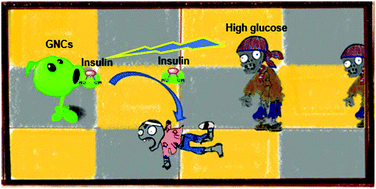Gold nanoclusters for controlled insulin release and glucose regulation in diabetes†
Abstract
Diabetes has become the third threat to public health worldwide. Traditional treatments of diabetes require frequent blood glucose testing and insulin injections, which not only bring great pain to patients but also exhibit difficulty in controlling the blood glucose accurately. In order to solve these problems, we developed a smart glucose-responsive insulin delivery system responding to the environmental glucose concentration based on gold nanoclusters (GNCs). First, we prepared GNCs as high drug-loading nanocarriers, and we decorated GNCs with phenylboronic acid molecules (4-carboxyphenylboronic acid (PBA) and 4-carboxy-3-fluorophenylboronic acid (FPBA)) as responsive ligands; then, we grafted insulin on the surface to form glucose-responsive insulin-release nanocomplexes GNC-PBA-Ins and GNC-FPBA-Ins, respectively. In the in vitro test, these complexes exhibited high sensitivity to glucose concentrations and rapidly released insulin in a hyperglycemic state. In type 1 diabetic mice in vivo, these complexes could maintain the blood glucose levels of mice in a normoglycemic range for up to 48 h without peaks of hyperglycemia or hypoglycemia, where the GNC-FPBA-Ins complex showed a better regulation of glucose than the GNC-PBA-Ins complex. These gold nanocluster systems mimic the function of the natural pancreas for blood glucose control, which has great potentials for the diagnosis and treatment of diabetes in the future.



 Please wait while we load your content...
Please wait while we load your content...